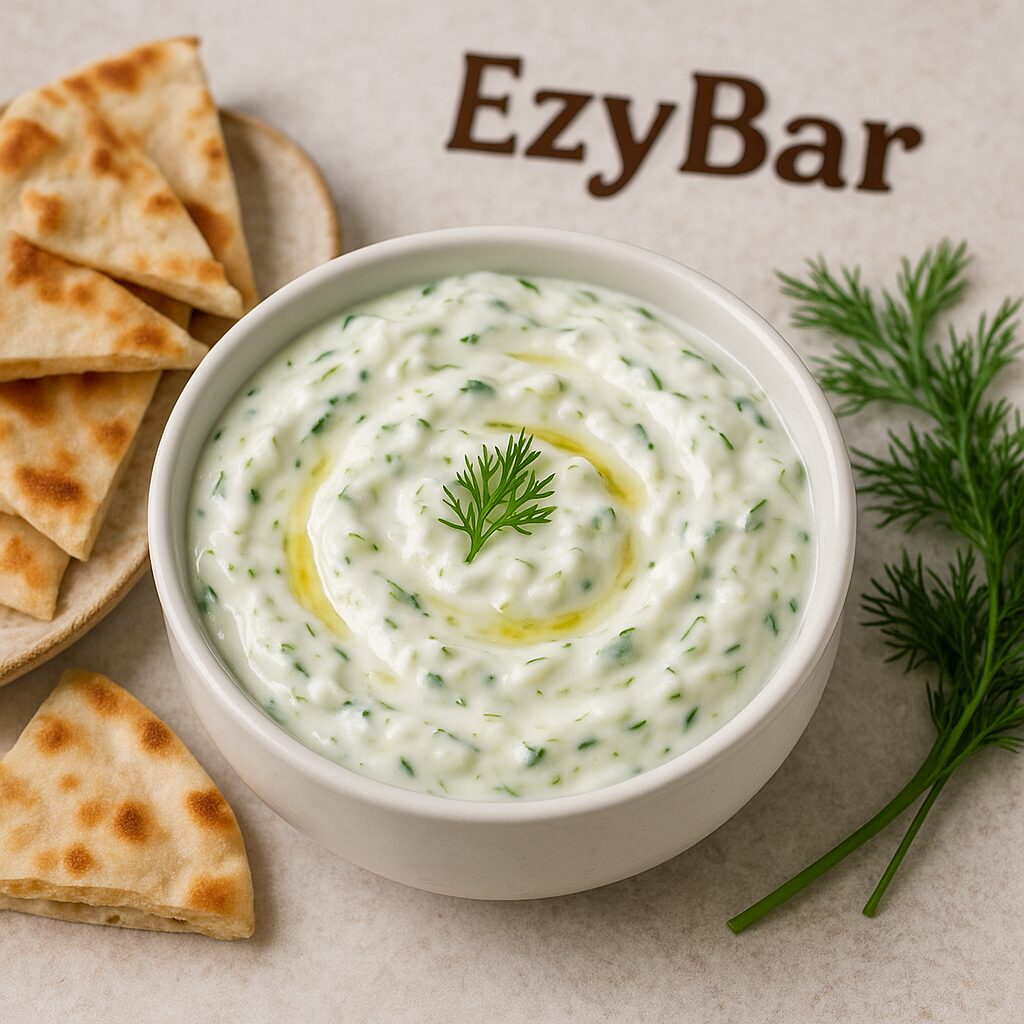Tzatziki: Quick and Simple Guide
Click play Button to listen full recipe In Audio!
Summary
Tzatziki is a classic Greek yoghurt sauce known for its refreshing taste and creamy texture. This simple and quick guide will teach you how to make authentic tzatziki in no time. The combination of cool cucumber, rich Greek yoghurt, and aromatic garlic creates a versatile dip that elevates any meal. It’s perfect as a spread for sandwiches, a dip for pita bread, or a tangy sauce drizzled over grilled meats. Even a novice cook can master this tzatziki recipe and bring a touch of the Mediterranean to the table.
Equipment for Making Tzatziki
- Mixing bowl
- Grater (for cucumber)
- Strainer or cheesecloth (to drain the cucumber)
- A cutting board and a knife are needed for chopping garlic and herbs.
- Spoon or spatula (for mixing)
Ingredients for Tzatziki
- Greek yoghurt: 2 cups of plain Greek yoghurt (use full-fat for richness, or low-fat for a lighter version)
- Cucumber: 1 large cucumber (English cucumber is ideal), peeled and seeds removed.
- Garlic: 2–3 cloves of garlic, minced (adjust to taste)
- Olive oil: 2 tablespoons of extra virgin olive oil
- Acid: 1 tablespoon fresh lemon juice (or white wine vinegar, for a subtle tang)
- Fresh herbs: 2 tablespoons chopped fresh dill (traditional) or mint (for a different twist)
- Salt: 1/2 teaspoon (to taste)
- Black pepper: A pinch of black pepper (optional, for a hint of spice)
Instructions: How to Make Tzatziki
- Prep the cucumber: Start by grating the cucumber using a grater. If the cucumber has a thick skin or large seeds, peel them and remove them before grating. Sprinkle a pinch of salt over the grated cucumber and let it sit for about 10 minutes. This will draw out excess water. After resting, place the cucumber in a strainer or wrap it in cheesecloth. Squeeze firmly to remove as much liquid as possible. Properly drained cucumber prevents watery tzatziki and ensures a thick, satisfying sauce.
- Mix the base: In a mixing bowl, combine the Greek yoghurt and the drained cucumber, stirring until the mixture is uniform. The yoghurt provides a creamy base, and the cucumber adds a refreshing bite without excess water (thanks to the draining step).
- Add garlic and flavourings: Add the minced garlic to the bowl. Pour in the extra virgin olive oil and the lemon juice (or vinegar). Stir well to combine all these ingredients thoroughly. The olive oil enriches the sauce and helps carry the flavours. Meanwhile, the lemon juice adds a bright note that balances the yoghurt’s richness.
- Incorporate herbs and seasonings: Fold in the chopped fresh dill (or mint). Mix gently until the herbs are evenly distributed, creating green flecks throughout the white yoghurt. Now add the salt and a pinch of black pepper. Stir again and then taste your tzatziki. The goal is a balanced flavour – creamy, tangy, and aromatic. Adjust the seasoning if needed: add more garlic for pungency, a bit more salt for depth, or an extra squeeze of lemon if you prefer more zing.
- Chill and serve: For the best result, cover the bowl and let the tzatziki chill in the refrigerator for at least 30 minutes. Chilling allows the flavours to meld and develop. When ready to serve, could you give it a final stir? Transfer the tzatziki to a serving bowl and drizzle olive oil on top for a professional touch. You can also garnish with a sprig of dill or a few cucumber slices. Serve this creamy tzatziki as a dip with warm pita bread and fresh vegetables, or as a sauce alongside your favourite grilled meats and kebabs.

Notes and Tips on Tzatziki
- Use thick yoghurt: Traditional tzatziki uses strained Greek yoghurt to achieve a rich, creamy consistency. If you only have regular yoghurt, strain it through a cheesecloth for a few hours to remove excess whey. Using a thicker yoghurt yields a more luscious, creamier tzatziki.
- Herb choices: Dill gives tzatziki its signature fresh flavour, but you can use mint for a cooler, slightly sweet profile. Some chefs even blend dill and mint for depth. Always use fresh herbs rather than dried for the most vibrant taste.
- Garlic intensity: The pungency of raw garlic is part of tzatziki’s character. If you prefer a milder garlic presence, start with two small cloves. For true garlic lovers, feel free to add a fourth clove. To evenly distribute the garlic and temper its heat, mash the cloves into a paste with a pinch of salt before mixing them in.
- Make ahead: Tzatziki often tastes even better after a few hours as the flavours mingle. You can prepare it a day in advance and store it in an airtight container in the refrigerator. This also saves time if you plan to serve it for a gathering. Just stir it before serving, as some liquid might separate on top over time.
- Serving suggestions: Tzatziki is a versatile condiment. Beyond serving it with pita and souvlaki, try it as a spread in sandwiches or wraps (it can replace mayonnaise for a healthier, tangy kick). It’s also fantastic as a side for spicy dishes — its coolness complements heat. Think of pairing tzatziki with spicy curries or chilli; it works similarly to a raita or sour cream to soothe the palate.
